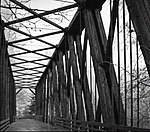McAlmond House

McAlmond House is a Gothic Revival farmhouse that built in 1862. The house stands on the bluffs of Dungeness near Sequim, Clallam County, Washington. The house is the only remain of the New Dungeness settlement, founded by New England sailors in the 1850s, and was built by ship's carpenters for the Captain Elijah H. McAlmond, which served as Justice of the Peace, first county commissioner, sheriff, Deputy United States Marshall, Probate Judge and, in 1863, as a member of the Territorial Legislature. The home remained in the McAlmond family until the mid-1900s, when the last remaining property was put up for sale. Local legends claim that under Capt. McAlmond's stewardship, the bluffs under the house were used to smuggle Chinese into the United States.The house was added to the National Register of Historic Places in 1976.
Excerpt from the Wikipedia article McAlmond House (License: CC BY-SA 3.0, Authors, Images).McAlmond House
Twin View Drive,
Geographical coordinates (GPS) Address Nearby Places Show on map
Geographical coordinates (GPS)
| Latitude | Longitude |
|---|---|
| N 48.14658 ° | E -123.13523 ° |
Address
Twin View Drive 242
98382
Washington, United States
Open on Google Maps








